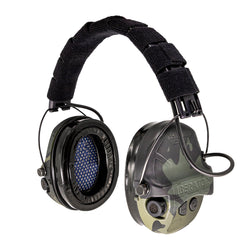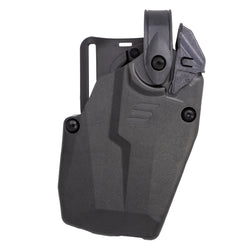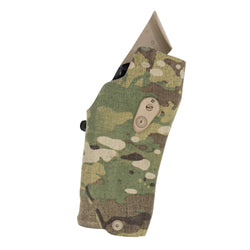The first time I strapped on a battle belt, I looked more like a Hollywood wannabe than anything else. Too many pouches, too much weight, and a setup that screamed tacticool more than practical.
I didn’t need half of what I had on there, but like a lot of folks, I was convinced that more gear equaled more capability. But I’m here to save you the trouble and let you know, straight up, that it doesn’t.
These days, the “minimalist” mindset is everywhere, and battle belts are no exception. Instead of cramming on everything the gear catalogs convince you to buy, the trend is toward streamlined rigs that carry only what you actually use. A good minimalist setup gives you speed, mobility, and just enough gear to cover the bases without weighing you down.
And if we’re being honest, most of us aren’t running belt-fed drills or fighting through mountains of ammo. We’re training, competing, or maybe setting up a defensive loadout for home or property protection. That means it’s not about carrying everything. It’s about carrying enough.
The Belt Itself
Let’s start at the ground level: the belt. The belt is the foundation, and a poor one will sag, twist, or start digging into your hips the moment you add weight to it. That is to say, if you cheap out here, you’ll regret it immediately.
I learned that lesson the hard way with an Amazon special years back. It looked decent out of the box, but once I strapped on a holster and a couple of mags, it felt like wearing a wet pool noodle.
Not great.
Minimalist doesn’t mean flimsy. The belt still needs to be stiff enough to support your gear but low-profile enough to avoid that bulky, overbuilt vibe. Two-piece designs dominate for a reason. Your inner belt threads through your pants’ belt loops, while the load-bearing outer belt attaches via Velcro. It’s fast on and off, doesn’t shift around, and keeps everything locked in place.

Some worth a look:
- Blue Force Gear CHLK Belt – Lightweight, laser-cut MOLLE, and comfortable for long wear.
- Ronin Tactics Senshi Belt – A bit more substantial, but it balances “overbuilt” with clean lines.
- Safariland 4333 Low-Profile Battle Belt – My personal favorite. If you’re running Safariland holsters already, this belt ties the system together.
Holster: The Non-Negotiable
I’ll admit: When I first started out, I treated holsters as just another piece of gear. Buy one, slap it on the belt, and call it good. That worked until the day a cheap Kydex holster dumped my pistol in the dirt during a simple drill.
Lesson learned. Never cheap out on your holster. Ever.

For a minimalist battle belt, the holster is the anchor point. You can swap mag pouches, add or ditch a dump pouch, but the holster? That’s staying put.
I run Safariland ALS-equipped holsters almost exclusively now, typically mounted on a QLS fork, allowing me to change holsters without redoing my entire setup. It gives me a consistent draw, protects the trigger, and adds retention without adding bulk.
That, and I can take the holster off my battle belt and put it on my normal EDC carry belt in just a matter of seconds. Seriously, I can’t stress it enough: you just can’t go wrong with Safariland holsters, coupled with the QLS system. It’s a no-brainer.
Rifle Mags: Less Is More
This is where belts usually go from practical to cosplay. I’ve seen rigs with four or five rifle mag pouches stacked across the hips like someone’s gearing up for a one-man war. It looks a little silly, and in the grand scheme of things, is incredibly impractical.
Again, carrying too much gear not only defeats the purpose of the minimalist mindset, but it also can become a bit of a liability.

I’ve found that one spare rifle mag is usually enough, maybe two if you’re doing extended drills. Realistically, if you’re at the range, you’ve got a bag full of mags right next to you anyway. For defensive use, one reload is all that most situations are going to demand.
Defensive, not offensive. That’s an entirely different can of worms.
For my belt, I reduced the number of pouches from three to one a while back, and honestly, I don’t miss the extra bulk. My reloads are cleaner, movement is easier, and my belt doesn’t feel like it’s pulling me sideways.
Pistol Mags: Keep It Lean
The same principle applies to pistol mags as it does to rifle mags. Unless you’re shooting a match that requires multiple reloads, you don’t need four pistol mags crowding your belt. One spare is often plenty, two at the absolute most.
Again, we’re looking for minimalism here.
I like keeping a single pistol mag pouch right next to the holster. It balances the belt, stays out of the way, and keeps my reloads consistent. Safariland makes slim, snag-free pouches that don’t eat up a lot of belt space. That’s a huge win in my book.
Also, I like to run my pistol mag pouch a hair forward of the centerline. It feels weird at first, but for reloads under stress, it’s faster and more natural than fishing behind your hip. Maybe that’s just a personal preference, but it works.
Med Kit: The One Thing You Can’t Skip
If you strip everything else from your belt, don’t skimp out on medical gear. Ever.
I’m lucky in that I’ve never experienced more than a few cuts on my knuckle or a twisted ankle at the range. But accidents can happen to anyone, anywhere, and at any time.
IFAKs and medical kits are one of those things that stay on my belt at all times under the “I’d rather have it and not need it than need it and not have it” principle.

Sure, they can be kinda bulky, but it’s a trade-off I’m willing to make.
That said, you don’t need a trauma surgeon’s kit. A tourniquet, a pressure bandage, a couple of chest seals, and some hemostatic gauze will handle 90% of what you’re likely to encounter on the range.
Minimalism doesn’t equate to recklessness. Carry the med gear. Always.
Dump Pouch: Optional, but Worth It
This one sparks debate. Some folks swear by a dump pouch; others think it’s just a catch-all for hoarders. I fall somewhere in the middle. On a minimalist belt, a dump pouch isn’t mandatory, but it’s nice to have.
I use mine less for empty magazines and more for random items, such as gloves, a water bottle, and sometimes even brass if I’m helping clean up the range at the end of the day.
The key is to keep it collapsible. Old-school dump pouches were bulky, flopped around, and felt like strapping a grocery bag to your hip. The modern versions fold flat until you need them, which keeps them in line with the minimalist ethos.
Keep It Honest
Here’s where I’ll admit something: my first “minimalist” belt wasn’t really minimalist. It was just slightly less bloated than my old setup. That’s the trap a lot of us fall into. We cut one mag pouch, drop a pouch or two we never use, and call it a day. But real minimalism means being brutally honest with yourself about what you actually need.

For me, that boiled down to:
- A pistol in a quality holster
- One spare pistol mag
- One rifle mag (two if I’m running drills)
- A med kit
- Optional dump pouch
That’s it. Everything else went back in the gear bin. And with it, my training got cleaner, and I was more limber. That, and I realized I’d been clinging to half that gear just because I didn’t want to admit I’d wasted money on it.
We all make mistakes, right?
The Bottom Line
Minimalist battle belts aren’t about impressing anyone. They’re about stripping away the excess until you’re left with a belt that’s fast, functional, and doesn’t weigh you down. Gun, holster, a few mags, an IFAK, and maybe a dump pouch. That’s all there is to it.
Once you run lean, you’ll wonder why you ever loaded yourself down with all that extra junk. Your draw will feel faster, your movement smoother, and your belt won’t feel like a burden you’re constantly adjusting.
Minimalism forces you to ask a simple question: Do I really need this? If the answer is no, leave it off. What you’re left with is gear that works, gear that matters, and nothing else.









